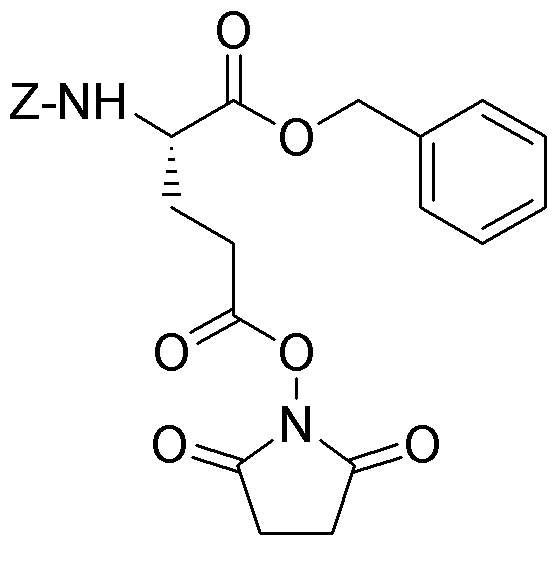Z-L-glutamic acid g-N-hydroxysuccinimide ester a-benzyl ester is widely utilized in research focused on:
- Peptide Synthesis: This compound serves as a valuable building block in the synthesis of peptides, allowing researchers to create complex structures efficiently. Its ability to form stable linkages enhances the yield and purity of the final products.
- Drug Development: In pharmaceutical research, it is used to modify drug molecules, improving their solubility and bioavailability. This modification can lead to more effective therapeutic agents with fewer side effects.
- Bioconjugation: The compound is employed in bioconjugation processes, where it helps attach biomolecules to surfaces or other molecules. This is particularly useful in creating targeted drug delivery systems and diagnostic tools.
- Research in Neuroscience: It plays a role in studying neurotransmitter pathways by acting as a glutamate analog. This application aids in understanding neurological disorders and developing potential treatments.
- Material Science: The compound is also explored in the development of advanced materials, such as hydrogels and coatings, which can be tailored for specific applications in biomedical engineering and nanotechnology.
General Information
Properties
Safety and Regulations
Applications
Z-L-glutamic acid g-N-hydroxysuccinimide ester a-benzyl ester is widely utilized in research focused on:
- Peptide Synthesis: This compound serves as a valuable building block in the synthesis of peptides, allowing researchers to create complex structures efficiently. Its ability to form stable linkages enhances the yield and purity of the final products.
- Drug Development: In pharmaceutical research, it is used to modify drug molecules, improving their solubility and bioavailability. This modification can lead to more effective therapeutic agents with fewer side effects.
- Bioconjugation: The compound is employed in bioconjugation processes, where it helps attach biomolecules to surfaces or other molecules. This is particularly useful in creating targeted drug delivery systems and diagnostic tools.
- Research in Neuroscience: It plays a role in studying neurotransmitter pathways by acting as a glutamate analog. This application aids in understanding neurological disorders and developing potential treatments.
- Material Science: The compound is also explored in the development of advanced materials, such as hydrogels and coatings, which can be tailored for specific applications in biomedical engineering and nanotechnology.
Documents
Safety Data Sheets (SDS)
The SDS provides comprehensive safety information on handling, storage, and disposal of the product.
Product Specification (PS)
The PS provides a comprehensive breakdown of the product’s properties, including chemical composition, physical state, purity, and storage requirements. It also details acceptable quality ranges and the product's intended applications.
Certificates of Analysis (COA)
Search for Certificates of Analysis (COA) by entering the products Lot Number. Lot and Batch Numbers can be found on a product’s label following the words ‘Lot’ or ‘Batch’.
Numéro de catalogue
Numéro de lot/série
Certificates Of Origin (COO)
This COO confirms the country where the product was manufactured, and also details the materials and components used in it and whether it is derived from natural, synthetic, or other specific sources. This certificate may be required for customs, trade, and regulatory compliance.
Numéro de catalogue
Numéro de lot/série
Safety Data Sheets (SDS)
The SDS provides comprehensive safety information on handling, storage, and disposal of the product.
DownloadProduct Specification (PS)
The PS provides a comprehensive breakdown of the product’s properties, including chemical composition, physical state, purity, and storage requirements. It also details acceptable quality ranges and the product's intended applications.
DownloadCertificates of Analysis (COA)
Search for Certificates of Analysis (COA) by entering the products Lot Number. Lot and Batch Numbers can be found on a product’s label following the words ‘Lot’ or ‘Batch’.
Numéro de catalogue
Numéro de lot/série
Certificates Of Origin (COO)
This COO confirms the country where the product was manufactured, and also details the materials and components used in it and whether it is derived from natural, synthetic, or other specific sources. This certificate may be required for customs, trade, and regulatory compliance.


